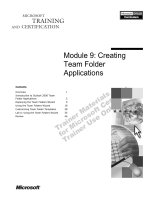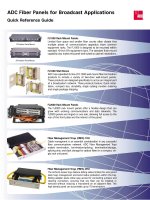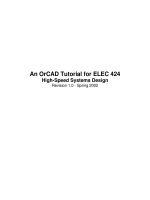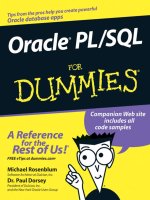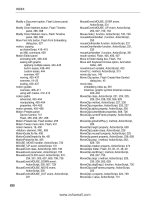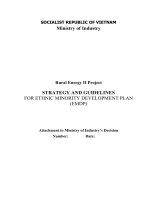Tài liệu Oracle Developer Guidelines for Building Applications pptx
Bạn đang xem bản rút gọn của tài liệu. Xem và tải ngay bản đầy đủ của tài liệu tại đây (2.23 MB, 332 trang )
Oracle Developer
Guidelines for Building Applications
Release 6.0
September, 1998
Part No. A58766-02
Oracle Developer: Guidelines for Building Applications, Release 6.0
Part No. A58766-02
Release 6.0
Copyright © 1998, Oracle Corporation. All rights reserved.
Portions copyright © Blue Sky Software Corporation. All rights reserved.
Contributing Authors: Frederick Bethke, Marcie Caccamo, Ken Chu, Frank Rovitto
The programs are not intended for use in any nuclear, aviation, mass transit, medical, or other
inherently dangerous applications. It shall be licensee’s responsibility to take all appropriate fail-safe,
back up, redundancy and other measures to ensure the safe use of such applications if the Programs
are used for such purposes, and Oracle disclaims liability for any damages caused by such use of the
Programs.
This Program contains proprietary information of Oracle Corporation; it is provided under a license
agreement containing restrictions on use and disclosure and is also protected by copyright, patent and
other intellectual property law. Reverse engineering of the software is prohibited.
The information contained in this document is subject to change without notice. If you find any problems
in the documentation, please report them to us in writing. Oracle Corporation does not warrant that this
document is error free. No part of this document may be reproduced or transmitted in any form or by
any means, electronic or mechanical, for any purpose, without the express written permission of Oracle
Corporation
If this Program is delivered to a U.S. Government Agency of the Department of Defense, then it is
delivered with Restricted Rights and the following legend is applicable:
Restricted Rights Legend Programs delivered subject to the DOD FAR Supplement are "commercial
computer software" and use, duplication and disclosure of the Programs shall be subject to the licensing
restrictions set forth in the applicable Oracle license agreement. Otherwise, Programs delivered subject to
the Federal Acquisition Regulations are "restricted computer software" and use, duplication and
disclosure of the Programs shall be subject to the restrictions in FAR 52.227-14, Rights in Data -- General,
including Alternate III (June 1987). Oracle Corporation, 500 Oracle Parkway, Redwood City, CA 94065.
Oracle is a registered trademark, and Developer/2000, Express, Oracle Developer, Oracle Forms, Oracle
Graphics, Oracle Installer, Oracle Reports, Oracle Request Broker, Oracle Terminal, Oracle WebServer,
Oracle7, Oracle8, PL/SQL, and Web Request Broker are trademarks or registered trademarks of Oracle
Corporation. All other company or product names mentioned are used for identification purposes only
and may be trademarks of their respective owners.
iii
Contents
Send Us Your Comments
.................................................................................................................. xiii
Preface
........................................................................................................................................................... xv
Part I Guidelines for Building Applications
1 Managing Oracle Developer Applications
1.1 The Software Development Lifecycle: An Overview...................................................... 1-2
1.1.1 The Oracle Developer management strategy............................................................. 1-3
1.1.2 About Project Builder .................................................................................................... 1-3
1.1.2.1 Understanding Project Builder terminology....................................................... 1-4
1.1.2.2 How Project Builder affects existing development roles .................................. 1-6
1.1.3 Exploring Project Builder benefits............................................................................... 1-7
1.1.3.1 Associating modules with an application........................................................... 1-7
1.1.3.2 Automating actions based on file types............................................................... 1-7
1.1.3.3 Creating dependencies between modules........................................................... 1-8
1.1.3.4 Assigning default connection strings to modules.............................................. 1-9
1.1.3.5 Designating which modules are to be included in the final install set ........... 1-9
1.1.3.6 Sharing and porting project and subproject registry files................................. 1-9
1.1.3.7 Accessing other Oracle Developer and third party tools.................................. 1-9
1.1.3.8 Using source control packages with Oracle Developer .................................. 1-10
1.2 Managing Project Documents During Design and Development ............................... 1-10
1.2.1 Installing Project Builder............................................................................................. 1-11
1.2.1.1 Installing the project and user registries .......................................................... 1-11
1.2.2 Creating a project ......................................................................................................... 1-12
1.2.2.1 Creating a project: Project Administrator......................................................... 1-12
1.2.2.2 Creating a project: Team members.................................................................... 1-16
1.2.3 Working with projects and project documents........................................................ 1-18
1.2.3.1 Working with projects: Project Administrator ................................................ 1-19
iv Guidelines for Building Applications
1.2.3.2 Working with project documents: Team members......................................... 1-20
1.2.4 Managing projects and project documents across multiple platforms ................ 1-21
1.2.4.1 Managing projects across multiple platforms: Project Administrator......... 1-22
1.2.4.2 Managing project documents across multiple platforms: Team members . 1-22
1.3 Managing Project Documents During the Test Phase.................................................... 1-22
1.3.1 On the development side ............................................................................................ 1-23
1.3.1.1 The test phase: Project Administrator............................................................... 1-23
1.3.2 On the test side ............................................................................................................. 1-24
1.3.2.1 The test phase: Testers......................................................................................... 1-24
1.4 Managing Project Documents During the Release Phase.............................................. 1-25
1.4.1 On the development side ............................................................................................ 1-25
1.4.1.1 The release phase: Project Administrator......................................................... 1-25
1.5 Deploying Completed Applications................................................................................. 1-25
1.5.1 Before You Begin .......................................................................................................... 1-26
1.5.1.1 Terminology........................................................................................................... 1-26
1.5.1.2 The Oracle Installer files....................................................................................... 1-27
1.5.1.3 The contents of the DEPLOY directory.............................................................. 1-29
1.5.2 Making your application an installable product ..................................................... 1-30
1.5.2.1 Deploying your application on Windows......................................................... 1-31
2 Deploying Applications on the Web
2.1 Understanding the Oracle Developer Server .................................................................... 2-1
2.1.1 Introduction to the Oracle Developer Server............................................................. 2-1
2.1.1.1 The best of the Web and client/server................................................................. 2-2
2.1.1.2 Three-tiered architecture........................................................................................ 2-2
2.1.2 Benefits of the Oracle Developer Server ..................................................................... 2-3
2.1.3 Form Builder Web architecture.................................................................................... 2-5
2.1.3.1 About the Forms Client.......................................................................................... 2-5
2.1.3.2 About the Forms Server ......................................................................................... 2-6
2.1.4 Running Form Builder applications on the Web....................................................... 2-9
2.1.4.1 Security and encryption ....................................................................................... 2-10
2.1.5 Report Builder Web architecture................................................................................ 2-11
2.1.5.1 Static Reporting with the Web Wizard .............................................................. 2-12
2.1.5.2 Scheduling Reports with the Reports Server .................................................... 2-12
2.1.5.3 Dynamic Reporting with the Web Cartridge or CGI....................................... 2-12
2.1.6 Graphics Builder Web architecture............................................................................ 2-16
2.1.6.1 About the Graphics Client and Graphics Server.............................................. 2-16
2.1.6.2 About the Graphics Client ................................................................................... 2-17
2.1.6.3 About the Web server with Oracle Web Request Broker module ................. 2-17
2.1.6.4 About the Graphics Server................................................................................... 2-17
v
2.1.6.5 Call and response: Graphics Client and Graphics Server............................... 2-18
2.1.6.6 About display instances and session IDs .......................................................... 2-18
2.1.6.7 About using Graphics Builder parameters in URLs........................................ 2-20
2.2 Guidelines for Designing Web Applications................................................................... 2-21
2.2.1 General guidelines for designing Web applications............................................... 2-22
2.2.1.1 Using RUN_PRODUCT to integrate Oracle Developer applications ........... 2-22
2.2.1.2 Creating your own template HTML files.......................................................... 2-23
2.2.1.3 Creating an HTML application menu................................................................ 2-24
2.2.2 Guidelines for designing Form Builder Web applications .................................... 2-25
2.2.2.1 Using Designer/2000 with the Oracle Developer Server................................ 2-25
2.2.2.2 Reducing network traffic ..................................................................................... 2-25
2.2.2.3 Creating a generic GUI for Web-enabled Form Builder applications........... 2-26
2.2.2.4 Selecting fonts........................................................................................................ 2-26
2.2.2.5 Using the SHOW_DOCUMENT built-in........................................................... 2-27
2.2.2.6 Working with images........................................................................................... 2-27
2.2.2.7 Feature restrictions for forms on the Web......................................................... 2-27
2.2.3 Guidelines for designing Report Builder Web applications.................................. 2-28
2.2.3.1 About Web reports ............................................................................................... 2-28
2.2.3.2 Adding Web functionality................................................................................... 2-29
2.2.3.3 Selecting the output format................................................................................. 2-36
2.2.3.4 Helpful tips ............................................................................................................ 2-40
2.2.4 Guidelines for designing Graphics Builder Web applications.............................. 2-40
2.2.4.1 Using custom hyperlinks in Graphics Builder displays.................................. 2-41
3 Designing Visually Effective Applications
3.1 Understanding the Process ................................................................................................. 3-1
3.1.1 What are the stages? ...................................................................................................... 3-3
3.1.2 Defining user requirements.......................................................................................... 3-3
3.1.3 Planning the user interface ........................................................................................... 3-4
3.1.3.1 Creating your standards ........................................................................................ 3-5
3.1.3.2 Considering portability.......................................................................................... 3-6
3.1.3.3 Creating a prototype............................................................................................... 3-7
3.1.4 Building the user interface elements ........................................................................... 3-9
3.1.5 Gathering user feedback ............................................................................................... 3-9
3.2 Creating an Effective Form ................................................................................................ 3-10
3.2.1 Understanding forms .................................................................................................. 3-10
3.2.1.1 What is a module?................................................................................................. 3-10
3.2.1.2 What are forms, blocks, items, regions, and frames? ...................................... 3-11
3.2.1.3 What are windows and canvases?...................................................................... 3-12
3.2.2 Guidelines for building forms.................................................................................... 3-14
vi Guidelines for Building Applications
3.2.2.1 Using object libraries ............................................................................................ 3-15
3.2.2.2 Understanding basic design principles.............................................................. 3-16
3.2.2.3 Adding color.......................................................................................................... 3-18
3.2.2.4 Creating canvases.................................................................................................. 3-19
3.2.2.5 Creating windows................................................................................................. 3-21
3.2.2.6 Creating regions .................................................................................................... 3-22
3.2.2.7 Adding items to blocks......................................................................................... 3-23
3.2.2.8 Designing messages.............................................................................................. 3-27
3.2.2.9 Implementing online help.................................................................................... 3-29
3.2.2.10 Building effective menus...................................................................................... 3-30
3.3 Creating an Effective Report.............................................................................................. 3-30
3.3.1 Understanding Reports ............................................................................................... 3-31
3.3.2 Using Templates in Report Builder ........................................................................... 3-32
3.3.3 Understanding Layout Objects .................................................................................. 3-33
3.3.4 Controlling Layout Objects in Report Builder ......................................................... 3-33
3.3.4.1 Using anchors ........................................................................................................ 3-34
3.3.4.2 Using the Print Object On and Base Printing On properties.......................... 3-35
3.3.4.3 Understanding Horizontal and Vertical Elasticity........................................... 3-35
3.3.4.4 Using the Page Break Before and After property............................................. 3-36
3.3.4.5 Using the Page Protect property......................................................................... 3-37
3.3.4.6 Using the Keep with Anchoring Object property ............................................ 3-37
3.4 Creating an Effective Display ............................................................................................ 3-37
3.4.0.7 Choosing the Right Graph ................................................................................... 3-38
4 Performance Suggestions
4.1 Summary ................................................................................................................................ 4-1
4.2 Introduction: What Is Performance?.................................................................................. 4-5
4.2.1 Performance When?....................................................................................................... 4-5
4.2.2 Performance of What? ................................................................................................... 4-5
4.2.3 Interrelationships ........................................................................................................... 4-6
4.2.4 Trade-offs......................................................................................................................... 4-6
4.3 Measuring Performance ....................................................................................................... 4-7
4.3.1 Oracle Developer-Specific Measurements.................................................................. 4-7
4.3.1.1 Forms Measurements ............................................................................................. 4-7
4.3.1.2 Reports Measurements........................................................................................... 4-8
4.3.2 Server- and Network-Specific Measurements........................................................... 4-9
4.4 General Guidelines for Performance Improvement......................................................... 4-9
4.4.1 Upgrades of Hardware and Software ....................................................................... 4-10
4.4.1.1 Software Upgrades................................................................................................ 4-10
4.4.1.2 Hardware Upgrades............................................................................................. 4-11
vii
4.4.2 Suggestions for Data Usage....................................................................................... 4-11
4.4.2.1 Use Array Processing ........................................................................................... 4-11
4.4.2.2 Eliminate Redundant Queries............................................................................. 4-11
4.4.2.3 Improve Your Data Model................................................................................... 4-12
4.4.2.4 Use SQL and PL/SQL Efficiently ....................................................................... 4-12
4.4.2.5 Use Group Filters .................................................................................................. 4-14
4.4.2.6 Share Work Between Developer Components ................................................ 4-14
4.4.2.7 Move Wait Time Forward ................................................................................... 4-14
4.4.3 Forms-Specific Suggestions ........................................................................................ 4-15
4.4.3.1 Tune Your Array Processing............................................................................... 4-15
4.4.3.2 Base Data Blocks on Stored Procedures............................................................. 4-15
4.4.3.3 Optimize SQL Processing in Transactions ........................................................ 4-17
4.4.3.4 Optimize SQL Processing in Triggers................................................................ 4-18
4.4.3.5 Control Inter-Form Navigation........................................................................... 4-18
4.4.3.6 Raise the Record Group Fetch Size..................................................................... 4-18
4.4.3.7 Use LOBs instead of LONGs .............................................................................. 4-18
4.4.3.8 Erase Global Variables ........................................................................................ 4-19
4.4.3.9 Reduce Widget Creation on Microsoft Windows ........................................... 4-19
4.4.3.10 Examine the Necessity of Locking .................................................................... 4-19
4.4.4 Reports-Specific Suggestions...................................................................................... 4-19
4.4.4.1 Areas to Focus On................................................................................................. 4-20
4.4.4.2 Reduce Layout Overhead .................................................................................... 4-20
4.4.4.3 Use Format Triggers Carefully .......................................................................... 4-20
4.4.4.4 Consider Linking Tables ..................................................................................... 4-21
4.4.4.5 Control Your Runtime Parameter Settings ...................................................... 4-22
4.4.4.6 Turn Off Debug Mode ......................................................................................... 4-22
4.4.4.7 Use Transparent Objects ..................................................................................... 4-22
4.4.4.8 Use Fixed Sizes for Non-Graphical Objects ..................................................... 4-22
4.4.4.9 Use Variable Sizes for Graphical Objects ......................................................... 4-23
4.4.4.10 Use Image Resolution Reduction ...................................................................... 4-23
4.4.4.11 Avoid Word Wrapping ....................................................................................... 4-23
4.4.4.12 Simplify Formatting Attributes .......................................................................... 4-23
4.4.4.13 Limit Your Use of Break Groups ....................................................................... 4-24
4.4.4.14 Avoid Duplicate Work with Graphics Builder................................................. 4-24
4.4.4.15 Choose Between PL/SQL and User Exits ........................................................ 4-24
4.4.4.16 Use PL/SQL instead of SRW.DO_SQL for DML ............................................ 4-25
4.4.4.17 Evaluate the Use of Local PL/SQL..................................................................... 4-26
4.4.4.18 Use Multiple Attributes When Calling SRW.SET_ATTR ............................... 4-26
4.4.4.19 Adjust the ARRAYSIZE Parameter.................................................................... 4-26
4.4.4.20 Adjust the LONGCHUNK Parameter .............................................................. 4-26
4.4.4.21 Adjust the COPIES Parameter ........................................................................... 4-27
viii Guidelines for Building Applications
4.4.4.22 Avoid Fetch-Aheads in Previewing .................................................................. 4-27
4.4.4.23 Choose Appropriate Document Storage ........................................................... 4-28
4.4.4.24 Specify Path Variables for File Searching ......................................................... 4-28
4.4.4.25 Use the Multi-Tiered Server ............................................................................... 4-28
4.4.5 Graphics-Specific Suggestions.................................................................................... 4-29
4.4.5.1 Pre-Load Your Graphics Files ............................................................................. 4-29
4.4.5.2 Update Displays Only If Necessary ................................................................... 4-29
4.4.5.3 Move Display Updates Out of Loops................................................................. 4-29
4.4.5.4 Use Common Elements Wherever Possible ..................................................... 4-29
4.4.5.5 Limit the DO_SQL Procedure to DDL Statements .......................................... 4-29
4.4.5.6 Use Handles to Reference Objects ..................................................................... 4-30
4.4.5.7 Consider Not Using Shortcut Built-ins ............................................................. 4-30
4.5 In a Client/Server Structure............................................................................................... 4-30
4.5.0.8 Choose the Best Installation Configuration ...................................................... 4-30
4.5.0.9 Choose a Suitable Application Residence ........................................................ 4-31
4.6 In a Three-Tier Structure ................................................................................................... 4-31
4.6.1 Maximizing Tier 1 - Tier 2 Scalability ....................................................................... 4-31
4.6.1.1 Increase Network Bandwidth ............................................................................. 4-32
4.6.1.2 Minimize Changes to the Runtime User Interface .......................................... 4-32
4.6.1.3 Adjust Stacked Canvases ..................................................................................... 4-32
4.6.1.4 Perform Validation at a Higher Level ............................................................... 4-32
4.6.1.5 Avoid Enabling and Disabling Menu items ..................................................... 4-33
4.6.1.6 Keep Display Size Small ...................................................................................... 4-33
4.6.1.7 Identify Paths for Graphic URLs......................................................................... 4-33
4.6.1.8 Limit the Use of Multimedia .............................................................................. 4-33
4.6.1.9 Avoid Use of Animations Driven from the Application Server ................... 4-33
4.6.1.10 Take Advantage of Hyperlinks .......................................................................... 4-33
4.6.1.11 Put Code into Libraries ....................................................................................... 4-33
4.6.1.12 Reduce Start-up Overhead with JAR Files ....................................................... 4-34
4.6.1.13 Reduce Start-up Overhead with Pre-Loading ................................................. 4-34
4.6.1.14 Use Just-in-Time Compiling ............................................................................... 4-34
4.6.2 Maximizing Tier 2 - Tier 3 Scalability........................................................................ 4-34
4.6.3 Increase Tier 2 Power — Hardware .......................................................................... 4-34
4.6.4 Increase Tier 2 Power — Software ........................................................................... 4-35
5 Designing Multilingual Applications
5.1 National Language Support (NLS) ..................................................................................... 5-1
5.1.1 The language environment variables.......................................................................... 5-2
5.1.1.1 NLS_LANG.............................................................................................................. 5-2
5.1.1.2 DEVELOPER_NLS_LANG and USER_NLS_LANG......................................... 5-3
ix
5.1.2 Character sets.................................................................................................................. 5-4
5.1.2.1 Character set design considerations..................................................................... 5-4
5.1.2.2 Font aliasing on Windows platforms................................................................... 5-5
5.1.3 Language and territory.................................................................................................. 5-5
5.1.4 Bidirectional support..................................................................................................... 5-6
5.1.4.1 Bidirectional support in Form Builder................................................................. 5-7
5.1.4.2 Bidirectional support in Report Builder .............................................................. 5-8
5.1.5 Unicode............................................................................................................................ 5-8
5.1.5.1 Unicode support in Oracle Developer................................................................. 5-9
5.1.5.2 Font support .......................................................................................................... 5-10
5.1.5.3 Enabling Unicode support................................................................................... 5-10
5.2 Using National Language Support During Development............................................ 5-10
5.2.1 Format masks................................................................................................................ 5-11
5.2.1.1 Format mask design considerations................................................................... 5-11
5.2.1.2 Default format masks........................................................................................... 5-11
5.2.1.3 Format mask characters ....................................................................................... 5-12
5.2.2 Sorting character data.................................................................................................. 5-13
5.2.2.1 Comparing strings in a WHERE clause............................................................. 5-13
5.2.2.2 Controlling an ORDER BY clause....................................................................... 5-14
5.2.3 NLS parameters............................................................................................................ 5-14
5.2.3.1 Using ALTER SESSION ....................................................................................... 5-14
5.2.3.2 Using NLS parameters in SQL functions .......................................................... 5-16
5.2.3.3 Form Builder NLS parameters............................................................................ 5-16
5.2.3.4 Report Builder report definition files................................................................. 5-17
5.3 Translating Your Applications.......................................................................................... 5-18
5.3.1 Translating your applications using Translation Builder ...................................... 5-18
5.3.1.1 Advantages ............................................................................................................ 5-19
5.3.1.2 Disadvantages ....................................................................................................... 5-19
5.3.2 Translating your applications using runtime language switching....................... 5-19
5.3.2.1 Advantages ............................................................................................................ 5-20
5.3.2.2 Disadvantages ....................................................................................................... 5-20
5.3.3 Using PL/SQL libraries for strings in code.............................................................. 5-20
5.3.4 Screen design considerations...................................................................................... 5-21
6 Designing Portable Applications
6.1 Before You Begin ................................................................................................................... 6-2
6.2 Designing Portable Forms.................................................................................................... 6-2
6.2.1 Considering the GUI...................................................................................................... 6-2
6.2.1.1 Choosing a coordinate system .............................................................................. 6-3
6.2.1.2 Considering monitors............................................................................................. 6-3
x Guidelines for Building Applications
6.2.1.3 Using color ............................................................................................................... 6-4
6.2.1.4 Resolving font issues ............................................................................................. 6-5
6.2.1.5 Using icons............................................................................................................... 6-6
6.2.1.6 Using buttons........................................................................................................... 6-7
6.2.1.7 Creating menus ....................................................................................................... 6-7
6.2.1.8 Creating the console................................................................................................ 6-8
6.2.1.9 Miscellaneous .......................................................................................................... 6-8
6.2.2 Considering the operating system............................................................................... 6-9
6.2.2.1 Including user exits............................................................................................... 6-11
6.2.3 Strategies for developing cross-platform forms ...................................................... 6-11
6.2.3.1 Creating a single source ....................................................................................... 6-12
6.2.3.2 Subclassing visual attributes ............................................................................... 6-13
6.2.3.3 Using the get_application_property built-in..................................................... 6-13
6.2.3.4 Hiding objects........................................................................................................ 6-14
6.2.4 Designing forms for character-mode......................................................................... 6-14
6.3 Designing Portable Reports ............................................................................................... 6-17
6.3.1 Designing a report for character-mode environments ........................................... 6-18
6.3.1.1 Design considerations .......................................................................................... 6-19
6.4 Designing Portable Displays.............................................................................................. 6-19
7 Taking Advantage of Oracle Developer’s Open Architecture
7.1 Working with OLE Objects and ActiveX Controls.......................................................... 7-2
7.1.1 What is OLE?................................................................................................................... 7-2
7.1.1.1 When should I use OLE within Oracle Developer? ........................................... 7-2
7.1.1.2 About OLE servers and containers....................................................................... 7-3
7.1.1.3 About embedded and linked objects.................................................................... 7-3
7.1.1.4 About the registration database............................................................................ 7-4
7.1.1.5 About OLE activation styles.................................................................................. 7-4
7.1.1.6 About OLE automation.......................................................................................... 7-5
7.1.1.7 OLE support in Oracle Developer........................................................................ 7-6
7.1.1.8 OLE guidelines ...................................................................................................... 7-13
7.1.1.9 Adding an OLE object to your application ....................................................... 7-14
7.1.1.10 Manipulating OLE objects ................................................................................... 7-14
7.1.1.11 OLE examples........................................................................................................ 7-15
7.1.2 What are ActiveX controls?......................................................................................... 7-18
7.1.2.1 When should I use ActiveX controls within Oracle Developer?.................... 7-19
7.1.2.2 Manipulating ActiveX controls........................................................................... 7-19
7.1.2.3 Responding to ActiveX events ............................................................................ 7-19
7.1.2.4 Deploying your ActiveX control......................................................................... 7-20
7.1.2.5 ActiveX support in Oracle Developer................................................................ 7-21
xi
7.1.2.6 ActiveX guidelines................................................................................................ 7-22
7.1.2.7 Adding an ActiveX control to your application............................................... 7-25
7.1.2.8 ActiveX examples.................................................................................................. 7-25
7.2 Using Foreign Functions to Customize Your Applications .......................................... 7-27
7.2.1 What are foreign functions?........................................................................................ 7-27
7.2.1.1 When should I use a foreign function?.............................................................. 7-27
7.2.1.2 Foreign function types ......................................................................................... 7-28
7.2.2 The foreign function interface .................................................................................... 7-28
7.2.3 Foreign function guidelines........................................................................................ 7-30
7.2.4 Creating a foreign function......................................................................................... 7-32
7.2.4.1 Creating an ORA_FFI interface to a foreign function...................................... 7-32
7.2.4.2 Creating a user exit interface to a foreign function.......................................... 7-36
7.2.5 Foreign function examples.......................................................................................... 7-39
7.2.5.1 Using ORA_FFI to call Windows help............................................................... 7-39
7.2.5.2 Using ORA_FFI to open the File Open dialog on Windows .......................... 7-42
7.2.5.3 Using ORA_FFI to call Unix(SUN) executables with a STDIN/STDOUT type interface
7-44
7.3 Using the Open API to Build and Modify Form Builder Applications....................... 7-53
7.3.1 What is the Open API? ................................................................................................ 7-53
7.3.1.1 When should I use the Open API? ..................................................................... 7-53
7.3.1.2 Open API header files .......................................................................................... 7-53
7.3.1.3 Open API properties............................................................................................. 7-55
7.3.1.4 Open API functions and macros......................................................................... 7-55
7.3.2 Guidelines for using the Open API ........................................................................... 7-56
7.3.3 Using the Open API..................................................................................................... 7-56
7.3.3.1 Creating and modifying modules using the Open API .................................. 7-56
7.3.4 Open API examples ..................................................................................................... 7-57
7.3.4.1 Modifying modules using the Open API .......................................................... 7-57
7.3.4.2 Creating modules using the Open API.............................................................. 7-60
7.4 Designing Applications to Run against ODBC Datasources ........................................ 7-71
7.4.1 What is the Oracle Open Client Adapter (OCA)? ................................................... 7-71
7.4.1.1 When should I use OCA? .................................................................................... 7-71
7.4.1.2 OCA architecture .................................................................................................. 7-71
7.4.1.3 Establishing an ODBC connection...................................................................... 7-72
7.4.1.4 ODBC drivers ........................................................................................................ 7-72
7.4.1.5 OPENDB.PLL ........................................................................................................ 7-72
7.4.2 Open datasource guidelines ....................................................................................... 7-73
7.4.3 Configuring Oracle Developer to run against an ODBC datasource ................... 7-75
Part II Appendices
xii Guidelines for Building Applications
A Working with Template HTML Files
A.1 About Template HTML Files............................................................................................... A-1
A.2 Working with the Cartridge HTML File Template .......................................................... A-2
A.2.1 Snapshot: The cartridge HTML file template............................................................ A-3
A.2.2 Modifying the cartridge HTML file template ............................................................ A-4
A.2.3 Examples of customized cartridge HTML files ......................................................... A-5
A.2.3.1 Example 1 ................................................................................................................. A-5
A.2.3.2 Example 2 ................................................................................................................. A-6
A.3 Working with the Static (Non-Cartridge) HTML File Template.................................... A-7
A.3.1 Snapshot: The static (non-cartridge) HTML file template....................................... A-7
A.3.2 Customizing the static (non-cartridge) HTML file template ................................... A-8
A.3.3 Examples of customized static (non-cartridge) HTML files .................................... A-9
A.3.3.1 Example 1 ................................................................................................................. A-9
A.3.3.2 Example 2 ............................................................................................................... A-10
B Including Application-Specific Settings
B.1 About Application Classes................................................................................................... B-1
B.2 Referencing an application class ......................................................................................... B-2
B.3 Setting an icon directory path for an application class .................................................... B-3
B.4 Creating font-mapping settings for an application class................................................. B-4
Part III Glossary and Index
Glossary
......................................................................................................................................... Glossary-1
Index
......................................................................................................................................... Index-1
xiii
Send Us Your Comments
Oracle Developer: Guidelines for Building Applications
Part No. A58766-02
Oracle Corporation welcomes your comments and suggestions on the quality and usefulness of this
publication. Your input is an important part of the information used for revision.
■
Did you find any errors?
■
Is the information clearly presented?
■
Do you need more information? If so, where?
■
Are the examples correct? Do you need more examples?
■
What features did you like most about this manual?
If you find any errors or have any other suggestions for improvement, please indicate the chapter,
section, and page number (if available), and email them to
xiv Guidelines for Building Applications
xv
Preface
The guidelines in this book are intended to help you fully exploit some of Oracle
Developer’s most powerful features. Whether you’ve been using Oracle Developer
for years or are brand new to the product, the concepts and suggestions provided in
this book should make it easier for you to complete such tasks as deploying an
existing Oracle Developer application on the Web, designing an effective graphical
user interface, or tracking and managing the disparate modules that make up a sin-
gle application.
How does this book fit in with Oracle Developer online help? While you can always
rely on the online help to explain how to accomplish a given task or which options
are available to you within a product, this book helps you determine why you’d
want to choose one option over another and to understand the consequences of
each decision. Use this book to help develop your strategy; use the online help for
instructions on implementing that strategy.
These guidelines represent the combined experience of Oracle Developer custom-
ers, marketing representatives, sales consultants, and the Oracle Applications
group. You may want to use these guidelines as the basis for developing your own
company standards, or use them simply to augment the standards you already have
in place.
Intended Audience
This book is intended for anyone who uses Oracle Developer to build applications.
The needs of both novice and advanced users are addressed.
xvi
Structure
This book contains the following chapters:
Chapter Description
Chapter 1, “Managing Oracle
Developer Applications”
Explains how to use the tools currently avail-
able with Oracle Developer to set up and man-
age the development of applications. Topics
include:
■
Setting up and administering projects
■
Enabling team development under a vari-
ety of networking scenarios
■
Source-controlling projects
■
Exporting projects between platforms
Exporting projects to different environments
during the application lifecycle
Chapter 2, “Deploying Applica-
tions on the Web”
Provides examples and guidelines for configur-
ing, designing, and deploying applications on
the Web.
Chapter 3, “Designing Visually
Effective Applications”
Presents visual considerations for developing
Oracle Developer applications using Form
Builder, Report Builder, and Graphics Builder.
Chapter 4, “Performance Sugges-
tions”
Detailed suggestions for improving the perfor-
mance of Oracle Developer applications.
Chapter 5, “Designing Multilin-
gual Applications”
Explains how to design multilingual applica-
tions with Oracle Developer.
Chapter 6, “Designing Portable
Applications”
Discusses how to develop an application that
can be easily ported across Windows 95, Mac-
intosh, and UNIX. Also discusses developing
for character mode terminals.
xvii
Notational Conventions
The following conventions are used in this book:
Chapter 7, “Taking Advantage of
Oracle Developer’s Open Archi-
tecture”
Discusses how to use Oracle Developer to:
■
Create applications that include OLE
objects and ActiveX controls.
■
Customize your applications with foreign
functions.
■
Build and modify applications using the
Open API.
Run applications against ODBC-compliant
datasources.
Convention Meaning
boldface text Used for emphasis. Also used for button names,
labels, and other user interface elements.
italicized text Used to introduce new terms.
courier font Used for path and file names.
COURIER CAPS Used for:
■
File extensions (.PLL or .FMX)
■
Environment variables
■
SQL commands
■
Built-ins/package names
■
Executable names
Chapter Description
xviii
Part I
Guidelines for Building Applications
Guidelines for Building Applications
Managing Oracle Developer Applications 1-1
1
Managing Oracle Developer Applications
One of the most important aspects of application development is managing the
modules that make up an application. Large applications can consist of literally
thousands of modules, and millions of lines of code. In addition, modules which
are important to the project as a whole but which are not compiled into the
application itself (such as design specifications, test scripts, and documentation)
must also be tracked and maintained.
This chapter explains how to use Oracle Developer to help you manage the
application development process.
Section Description
Section 1.1, "The Software
Development Lifecycle:
An Overview"
Briefly covers the major milestones of application development
and discusses Oracle Developer’s Project Builder within that
framework.
Section 1.2, "Managing
Project Documents During
Design and Development"
Discusses how Oracle Developer can help manage documents
during development of an application.
Section 1.3, "Managing
Project Documents During
the Test Phase"
Discusses how Oracle Developer can help ensure that your QA
group tests the correct configuration of project documents
during the test phase.
Section 1.4, "Managing
Project Documents During
the Release Phase"
Discusses how Oracle Developer can help ensure that an
installable version of your application is delivered to your
customers.
Section 1.5, "Deploying
Completed Applications"
Discusses how to turn your own application into one that is
installable by the Oracle Installer.
The Software Development Lifecycle: An Overview
1-2 Oracle Developer: Guidelines for Building Applications
1.1 The Software Development Lifecycle: An Overview
Application development typically occurs in four phases:
■
Design. The initial specification for the application is developed. This
specification can be based on a variety of sources: customer feedback, input of
project management or development team members, requests for enhancement,
necessary bug fixes, or systems analysis.
■
Develop. Individual modules are created or modified, possibly incorporating a
wide variety of languages, tools, or platforms.
■
Test. The modules are tested. This generally occurs in two stages: unit test and
system test. Unit test is testing at a modular or functional level; for example,
testing UI elements such as menus or buttons. System test tests the integration
of major portions of the code; the backend with the UI, for example.
■
Deploy. The modules are packaged together in an installable form and
delivered to customers.
Figure 1–1 The phases of the development lifecycle: input and deliverables
As the application grows in size and complexity, the four phases are repeated
iteratively, and the amount of information produced (actual code, bug reports,
enhancement requests, etc.) grows. Yet all input and deliverables for all phases
must be tracked and maintained to ensure the integrity of the final deliverable: the
application your customer installs.
The Software Development Lifecycle: An Overview
Managing Oracle Developer Applications 1-3
This chapter discusses how to use Oracle Developer to manage your application’s
code base and maintain version integrity.
1.1.1 The Oracle Developer management strategy
In any development project, management tasks can be split roughly into two
categories:
■
Project management, which includes allocating the necessary equipment,
budget, and person-hours of work necessary to complete the development of
the application.
■
Software configuration management, which includes assigning modules to
developers, determining dependencies among modules, maintaining the code
under development, and version control.
Project Builder, the latest addition to Oracle Developer’s suite of powerful tools,
enables you to simplify your software configuration management tasks so you and
your team can focus on your primary objectives: designing, coding, and testing
applications.
1.1.2 About Project Builder
To help simplify your software management tasks, Project Builder provides the
means for you to:
■
Associate modules with an application or component of an application.
■
Automate actions based on file types.
■
Create dependencies between modules and indicate how changes cascade; in
other words, show which modules need to be recompiled based on changes to
other modules.
■
Assign default connection strings to modules.
■
Designate which modules are to be included in the final install set.
■
Share projects and subprojects among team members and port them to different
environments.
■
Invoke other Oracle Developer and third party tools from the Project Builder
user interface.
These features are described in detail in Section 1.1.3, "Exploring Project Builder
benefits". If you’re unfamiliar with Project Builder teminology, however, it’s a good
idea to read through Section 1.1.2.1, "Understanding Project Builder terminology"
The Software Development Lifecycle: An Overview
1-4 Oracle Developer: Guidelines for Building Applications
before proceeding. This section defines some basic terms which provide the context
for a discussion of Project Builder’s features.
1.1.2.1 Understanding Project Builder terminology
Project Builder is based upon the concepts of projects and subprojects:
■
Projects are collections of pointers to the modules and files that are part of your
application.
■
Subprojects are projects contained within other projects, providing a finer level
of organizational granularity. Often the organization of files into subprojects
mirrors the organization of files into subdirectories, but this is not a
requirement.
In addition to projects and subprojects, these terms are also central to a solid
understanding of Project Builder:
■
Types. A type is the basis of every item, and controls the actions that are
available in Project Builder. Project Builder types recognize their associated file
types primarily by default extension; for example,
.TXT
for text files. Project
Builder predefines types for many commonly used files, such as forms
documents (
FMB
), text files, and C source files. You can also use the Type
Wizard to define types for other applications.
■
Project items. The components that make up a project are known as items. An
item is simply a description of a file that is part of a project. Each item is fully
described in the associated Property Palette, which lists the item’s type, location
in the file system, size, and when it was last modified. The actions and macros
(see below) for the item are also defined.
It is important to remember that an item is not the file itself; rather, it is a
description of the file. So, when you delete an item from a project, you are
simply telling Project Builder that the file is no longer part of the project. The
file itself is not deleted.
■
Actions. Actions are command strings that apply to files of a given type; for
example, the Edit action for a text item may be the command string that invokes
Notepad or WordPad.
■
Macros. Macros are variables you can use to modify actions. A macro may be
either a constant or a simple expression (which, in turn, may contain other
constants and/or expressions). For example, Project Builder inserts all the
information you’ve specified for connecting to a database into the ORACONNECT
macro, which is included in all commands that might require you to connect.
The Software Development Lifecycle: An Overview
Managing Oracle Developer Applications 1-5
The information in the macro is then inserted into the action so you can log on
automatically.
Just as you might use environment variable in scripts or batch files to
conveniently modify a script’s actions without editing the script itself, so you
can use macros to customize actions without having to edit the action
themselves. For example, you might define a macro to determine whether to
compile your application in Debug mode or Optimized mode. In preparation
for building the deployment version of the application, you would simply
change one macro definition to switch off Debug, rather than having to find and
modify every type whose Build command made use of the Debug flag.
■
Global registry. The Global Registry contains the pre-defined Project Builder
types.
■
User registry. Each user has a user registry in which to define new types,
redefine existing types, and modify or create actions or macros.
■
Project registry file. The project registry file contains information necessary to
track a project, including pointers to modules contained within the project,
default connection strings, and a pointer to the "home" directory for the project.
The Project Builder interface provides three tools for manipulating the items that
make up a project:
■
The Project Navigator furnishes a familiar "navigator" or "explorer" style
interface with which you can view the modules in your application. In
addition, you can use Project Builder’s filtering capabilities to display only the
modules you want to see. You can also launch editing tools directly from the
Project Navigator.
■
The Property Palette enables you to examine and modify the properties of
selected items.
■
The Launcher, a secondary toolbar, provides another means of accessing
development tools. You can even add buttons to the Launcher and associate
them with your favorite third-party tools.
